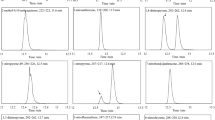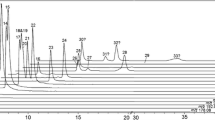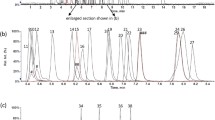Abstract
Due to several polycyclic aromatic hydrocarbons (PAHs) being highly carcinogenic and at the same time occurring at very low environmental concentrations up to the microgram per kilogram range, highly sensitive chemical analysis in various matrices is needed. Here, for the first time, a method using gas chromatography (GC) and atmospheric pressure laser ionization-mass spectrometry (APLI-MS), which is much more sensitive compared to common GC-MS, proved to produce reliable (certified reference materials) and comparable (GC-MS) results. PAHs and selected isomers of alkyl-PAHs were targeted, whereby 53 analytes could be quantified individually; for one pair, the sum had to be calculated. In combination with the selective and sensitive (1+1)-REMPI process of the APLI, limits of detection (LODs) between 5 and 50 fg/μL could be obtained. To prove the reliability of this method, four certified reference materials (SRM1649b urban dust, SRM 1941b organics in marine sediment, BCR 535 fresh water harbor sediment, and ERM CC013a contaminated soil from a former gas plant site) were analyzed. The results were in good accordance with the certified values. In addition, analytical results of three different environmental matrices (bituminous coal, suspended particulate matter from river and pine needles) were compared to values obtained with well-established GC-EI-MS. The results show that this method presents an excellent tool ready-to-use for the analysis of environmental samples with very low PAH content or very low sample amount.





Similar content being viewed by others
References
Macdonald RW, Barrie LA, Bidleman TF, Diamond ML, Gregor DJ, Semkin RG, et al. Contaminants in the Canadian Arctic: 5 years of progress in understanding sources, occurrence and pathways. Sci Total Environ. 2000;254(2–3):93–234. doi:10.1016/S0048-9697(00)00434-4.
Li Y, Duan X. Polycyclic aromatic hydrocarbons in sediments of China Sea. Environ Sci Pollut Res. 2015;22(20):15432–42. doi:10.1007/s11356-015-5333-6.
Maertens RM, Bailey J, White PA. The mutagenic hazards of settled house dust: a review. Mutat Res Rev Mutat Res. 2004;567(2–3):401–25. doi:10.1016/j.mrrev.2004.08.004.
Stogiannidis E, Laane R. Source characterization of polycyclic aromatic hydrocarbons by using their molecular indices: an overview of possibilities. Rev Environ Contam T. 2015;234:49–133. doi:10.1007/978-3-319-10638-0_2.
Agency for Toxic Substances and Disease Registry, ATSDR. Toxicological profile for polycyclic aromatic hydrocarbons (PAHs) (1995).
Keith LH. The source of US EPA’s sixteen PAH priority pollutants. Polycycl Aromat Compd. 2015;35(2–4):147–60. doi:10.1080/10406638.2014.892886.
Zeddel A. Prüfwerte für PAK: Bewertung polyzyklischer aromatischer Kohlenwasserstoffe bezüglich des Wirkungspfades Boden-Mensch. Altlastenspektrum. 2016;6:2013–9.
Bundesministerium für Umwelt, Naturschutz, Bau und Reaktorsicherheit/Umweltbundesamt, BMUB/UBA. Die Wasserrahmenrichtlinie—Deutschlands Gewässer 2015. Bonn, Dessau (2016).
Kaisarevic S, Lubcke-von Varel U, Orcic D, Streck G, Schulze T, Pogrmic K, et al. Effect-directed analysis of contaminated sediment from the wastewater canal in Pancevo industrial area, Serbia. Chemosphere. 2009;77(7):907–13. doi:10.1016/j.chemosphere.2009.08.042.
Andersson J, Achten C. Time to say goodbye to the 16 EPA PAHs? Toward an up-to-date use of PACs for environmental purposes. Polycycl Aromat Compd. 2015;35(2–4):330–54. doi:10.1080/10406638.2014.991042.
Brack W, Schirmer K. Effect-directed identification of oxygen and sulfur heterocycles as major polycyclic aromatic cytochrome P4501A-inducers in a contaminated sediment. Environ Sci Technol. 2003;37(14):3062–70. doi:10.1021/es020248j.
Skoczynska E, Leonards P, de Boer J. Identification and quantification of methylated PAHs in sediment by two-dimensional gas chromatography/mass spectrometry. Anal Methods. 2013;5(1):213–8. doi:10.1039/c2ay25746g.
Seidel A, Frank H, Behnke A, Schneider D, Jacob J. Determination of dibenzo[a]pyrene and other fjord-region PAH isomers with MW 302 in environmental samples. Polycycl Aromat Compd. 2004;24(4–5):759–71. doi:10.1080/10406630490472527.
Durant JL, Lafleur AL, Plummer EF, Taghizadeh K, Busby WF, Thilly WG. Human lymphoblast mutagens in urban airborne particles. Environ Sci Technol. 1998;32(13):1894–906. doi:10.1021/es9706965.
Wang XT, Miao Y, Zhang Y, Li YC, Wu MH, Yu G. Polycyclic aromatic hydrocarbons (PAHs) in urban soils of the megacity Shanghai: occurrence, source apportionment and potential human health risk. Sci Total Environ. 2013;447:80–9. doi:10.1016/j.scitotenv.2012.12.086.
Anderson KA, Szelewski MJ, Wilson G, Quimby BD, Hoffman PD. Modified ion source triple quadrupole mass spectrometer gas chromatograph for polycyclic aromatic hydrocarbon analyses. J Chromatogr A. 2015;1419:89–98. doi:10.1016/j.chroma.2015.09.054.
Cai SS, Stevens J, Syage JA. Ultra high performance liquid chromatography-atmospheric pressure photoionization-mass spectrometry for high-sensitivity analysis of US Environmental Protection Agency sixteen priority pollutant polynuclear aromatic hydrocarbons in oysters. J Chromatogr A. 2012;1227:138–44. doi:10.1016/j.chroma.2011.12.111.
Stader C, Beer F, Achten C. Environmental PAH analysis by gas chromatography-atmospheric pressure laser ionization-time-of-flight-mass spectrometry (GC-APLI-MS). Anal Bioanal Chem. 2013;405(22):7041–52. doi:10.1007/s00216-013-7183-8.
Schiewek R, Schellentrager M, Monnikes R, Lorenz M, Giese R, Brockmann K, et al. Ultrasensitive determination of polycyclic aromatic compounds with atmospheric-pressure laser ionization as an interface for GC/MS. Anal Chem. 2007;79(11):4135–40. doi:10.1021/ac0700631.
Boesl U. Special feature: tutorial—laser mass spectrometry for environmental and industrial chemical trace analysis. J Mass Spectrom. 2000;35(3):289–304. doi:10.1002/(SICI)1096-9888(200003)35:3<289::AID-JMS960>3.3.CO;2-P.
Schrader W, Panda S, Brockmann K, Benter T. Characterization of non-polar aromatic hydrocarbons in crude oil using atmospheric pressure laser ionization and Fourier transform ion cyclotron resonance mass spectrometry (APLI FT-ICR MS). Analyst. 2008;133(7):867–9. doi:10.1039/b801031e.
Heger H, Zimmermann R, Dorfner R, Beckmann M, Griebel H, Kettrup A, et al. On-line emission analysis of polycyclic aromatic hydrocarbons down to pptv concentration levels in the flue gas of an incineration pilot plant with a mobile resonance enhanced multiphoton ionization time-of-flight mass spectrometer. Anal Chem. 1999;71(1):46–57. doi:10.1021/ac980611y.
Lababidi S, Panda SK, Andersson JT, Schrader W. Direct coupling of normal-phase high-performance liquid chromatography to atmospheric pressure laser ionization Fourier transform ion cyclotron resonance mass spectrometry for the characterization of crude oil. Anal Chem. 2013;85(20):9478–85. doi:10.1021/ac400670s.
Thiäner J, Achten C. Liquid chromatography–atmospheric pressure laser ionization–mass spectrometry(LC-APLI-MS) analysis of polycyclic aromatic hydrocarbons (including 6–8 ring) in the environment. Anal Bioanal Chem. 2016. doi:10.1007/s00216-016-0121-9.
Deibel E, Klink D, Schmitz OJ. New derivatization strategies for the ultrasensitive analysis of non-aromatic analytes with APLI-TOF-MS. Anal Bioanal Chem. 2015;407(24):7425–34.
Schiewek R, Monnikes R, Wulf V, Gab S, Brockmann KJ, Benter T, et al. A universal ionization label for the APLI-(TOF)MS analysis of small molecules and polymers. Angew Chem Int Edit. 2008;47(51):9989–92.
Wise SA, Sander LC, Schantz MM. Analytical methods for determination of polycyclic aromatic hydrocarbons (PAHs)—a historical perspective on the 16 US EPA priority pollutant PAHs. Polycycl Aromat Compd. 2015;35(2–4):187–247. doi:10.1080/10406638.2014.970291.
Achten C, Beer F, Stader C, Brinkhaus S. Wood-specific polycyclic aromatic hydrocarbon (PAH) patterns in soot using gas chromatography-atmospheric pressure laser ionization-mass spectrometry (GC-APLI-MS). Environ Forensic. 2015;16(1):42–50. doi:10.1080/15275922.2014.991004.
Meyer W, Seiler T, Christ A, Redelstein R, Puttmann W, Hollert H, et al. Mutagenicity, dioxin-like activity and bioaccumulation of alkylated picene and chrysene derivatives in a German lignite. Sci Total Environ. 2014;497:634–41. doi:10.1016/j.scitotenv.2014.07.103.
Li A, Song J, Sun Y, Jiao T. The application of resonance-enhanced multiphoton ionization technique in gas chromatography mass spectrometry. J Spectrosc. 2014. doi:10.1155/2014/134828.
Meyer W, Seiler TB, Reininghaus M, Schwarzbauer J, Puttmann W, Hollert H, et al. Limited waterborne acute toxicity of native polycyclic aromatic compounds from coals of different types compared to their total hazard potential. Environ Sci Technol. 2013;47(20):11766–75. doi:10.1021/es401609n.
Kauppila TJ, Kersten H, Benter T. Ionization of EPA contaminants in direct and dopant-assisted atmospheric pressure photoionization and atmospheric pressure laser ionization. J Am Soc Mass Spectrom. 2015;26(6):1036–45. doi:10.1007/s13361-015-1092-3.
Herbstein FH, Schmidt GMJ (1954) The structure of overcrowded aromatic compounds. 4. The crystal structure of tetrabenzonaphthalene. J Chem Soc :3314–3319. doi:10.1039/jr9540003314.
Biau DJ. In brief: standard deviation and standard error. Clin Orthop Relat Res. 2011;469(9):2661–4. doi:10.1007/s11999-011-1908-9.
Fajgelj A, Ambrus Á (2000) Guidelines for single-laboratory validation of analytical methods for trace-level concentrations of organic chemicals. In: Fajgelj A, Ambrus A (eds) Principles and practices of method validation. The Royal Society of Chemistry, Cambridge, pp 179–252. doi:10.1039/9781847551757-00179.
Guimaraes ED, Rodrigues JM, de la Cruz MHC, Sartori AV, de Souza V, Figueroa-Villar JD. Determination of PAHs: a practical example of validation and uncertainty assessment. J Chromatogr Sci. 2013;51(9):845–55.
Miller JN, Miller JC. Statistics and chemometrics for analytical chemistry, vol. 6. Harlow: Pearson Education Limited; 2010.
Acknowledgements
The authors would like to thank Prof. Dr. Jan T. Andersson (University of Münster, Institute of Inorganic and Analytical Chemistry) for the CRM and the single standards of alkylated PAHs, Jack Cochran (Restek Corporation) for the GC column, Prof. Dr. Jan Schwarzbauer (RWTH Aachen University, Laboratory for Organic-Geochemical Analysis of the Institute of Geology and Geochemistry of Petroleum and Coal) for the coal sample, and Dr. Matthias Ricking (University of Berlin, Institute of Geological Sciences) for the suspended particulate matter samples.
Author information
Authors and Affiliations
Corresponding author
Ethics declarations
Conflict of interest
The authors declare that they have no conflict of interest.
Human and animal rights and informed consent
No violation of human and animal rights occurred during this investigation.
Electronic supplementary material
Below is the link to the electronic supplementary material.
ESM 1
(PDF 585 kb)
Rights and permissions
About this article
Cite this article
Große Brinkhaus, S., Thiäner, J.B. & Achten, C. Ultra-high sensitive PAH analysis of certified reference materials and environmental samples by GC-APLI-MS. Anal Bioanal Chem 409, 2801–2812 (2017). https://doi.org/10.1007/s00216-017-0224-y
Received:
Revised:
Accepted:
Published:
Issue Date:
DOI: https://doi.org/10.1007/s00216-017-0224-y




